Displaying items by tag: Peter Malone's Movie Reviews
Abbott and Costello Meet Frankenstein
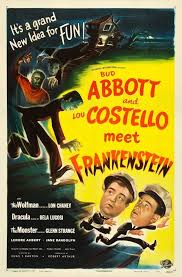
ABBOTT AND COSTELLO MEET FRANKENSTEIN
US, 20 1948, 83 minutes, Black-and-white.
Bud Abbott, Lou Costello, Lon Chaney Jr, Bela Lugosi, Glenn Strange, Lenore Aubert, Jane Randolph, Frank Ferguson.
Directed by Charles T. Barton.
Bud Abbott (the straight man) and Lou Costello (often the patsy) were very popular movie comedians in the 1940s and 1950s, very much of that period. A parallel, more upmarket could be Martin and Lewis. But, though not in the same class as the comedy duo, Laurel and Hardy.
This was the first of their series of Meet the… While Frankenstein is in the title, it refers to the Monster, not Dr Frankenstein. However, the next film was Meet the Killer Boris Karloff. Then there was a series of popular encounters with characters including Captain Kidd (Charles Laughton) Dr Jekyll and Mr Hyde, The Invisible man, the Keystone Kops.
This one, in fact, should have been called Meet Dracula because Bela Lugosi reprises his famous role and is central to the film. A subtitle could be Meet the Wolf Man because Lon Chaney Jr reprises his role as Lawrence Talbot, transformed at full moon into the Wolf Man. And, the finale, indicating future horror excursions, Vincent Price’s voice is heard as The Invisible Man.
On the one hand, there is the local story, the bumbling duo unpacking cargo, warned not to open two coffins but, of course, the opening, one, with Dracula, the other with The Monster. While there are a lot of visual references to the famous horror films, there is also a whole lot of bumbling comedy involving the duo, Dracula’s femme fatale assistant, Lou Costello’s girlfriend who is hypnotised by Dracula, a nice doctor, and the frustrated entrepreneur who is exhibiting the horror relics.
Audience response was very favourable, praising the horror aspects of the film, but it was intended as a smaller enjoyable entertainment from Universal Studios for the wide audience.
Duck Soup
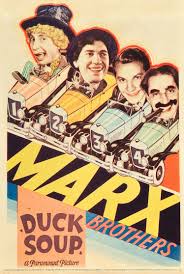
DUCK SOUP
US, 1933, 69 minutes, Black-and-white.
Groucho Marx, Harpo Marx, Chico Marx, Zeppo Marx, Margaret Dumont, Louis Calhern.
Directed by Leo McCarey.
A very early Marx Brothers film, many critics considering at their best. However, they were then to sign a contract with MGM and star in a series of very popular entertainments, A Night at the Operator, A Day at the Races, Go West, The Big Store.
The Marx Brothers were celebrated for their onstage comedy, a range of routines, Groucho, moustache and glasses, sloping walk, eyebrow raising, quips. And, Harpo, not speaking, mugging away, playing the harp when possible. Chico had his Italian accent and verbal mixups as well as his piano playing. Zeppo was the straight man and moved from films to business.
And, in seven films, the leading lady was the celebrated Margaret Dumont, tall, haughty, aristocratic, the butt of Groucho Marx’s jokes, but her continued devotion to his characters.
The screenplay, written by songwriters Harry Ruby and BertKalmar (as well as some songs here) takes up the popular theme of a European kingdom (think a 1930s style Prisoner of Zenda situation). The sets are quite something, re-creating the atmosphere of a European Castle and its interiors. And there is the pomp and circumstance of royalty, ambassadors, courts and judgements, political proceedings.
But, this is only a context for the comedy routines and performances with the Marx Brothers fulfilling all the above descriptions. They had already made Coconuts, Monkey Business, Animal Crackers so they had made the transition from stage to screen. In comparison with his other roles, Groucho is his usual self but a touch more subdued, on the edge of going full throttle. Harpo and Chico actually play two of the most inept spies and undercover agents you could find, Harpo finding a moment to play the strings on a grand piano.
Louis Calhern plays the insidious ambassador, terribly serious, the butt of a lot of the jokes, but going along with the proceedings.
Definitely for Marx Brothers fans but also a reminder of their early days.
Peninsula/ Train to Busan 2/ Busanhaeng 2: Bando
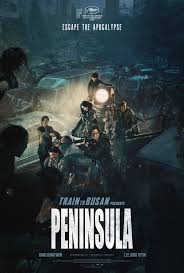
PENINSULA/TRAIN TO BUSAN: PENINSULA/ Busanhaeng 2: Bando
Japan, 2020, 116 minutes, Colour.
Koo Kyo-hwan, Gang Dong-won, Lee Jung-hyun.
Directed by Yeon Sang-ho.
There was great acclaim for the original film, Train to Busan, 2016, a thriller set on a train, a zombie film, a population threatened by the living dead, trapped on a train, victims of the zombies, and the authorities fighting to save the people.
This film has the same director and cowriter. However, the link is the rise of the zombies but none of the characters from the original film reappear. Once again, the atmosphere is created and attention given to the zombies and their attacks on the humans. However, the emphasis in this thriller is on the humans themselves, an opening where the hero is driving through the countryside with children, refusing to give help to any of those appealing along the way, saved but, after four years, not going to the Peninsula where they hoped for safety but rerouted to Hong Kong and a squalid existence, isolated ghettos of humans, the continued menace of the zombies.
The dramatic focus when the leader in the ghetto learns that there is a vast amount of American dollars back on the Korean mainland and a squad, including the hero, travel back to the Peninsula to recover the dollars. While they run the risk of the zombies, there is also the threat of the gangs on the mainland, rogue military leaders, many prisoners, and the setting up of a gladiatorial system where prisoners are exposed to the pursuing zombies, bets being made on who will survive.
The hero encounters the two girls, expert drivers, with devices for lighting up situations on ground drone situations. We meet their mother, the woman who was refused help along the way, the hero then feeling guilty, eventually confessing.
In the ensuing confrontations, the freeing of a friend, the rogue military man and his attack with his thugs, the leader of the Fort and his associate, recovering the money and wanting to escape, it is the woman who becomes the chief protagonist of the film, stepping into the role that would be expected to be taken by the man. An indication of changing patterns in action films at this time.
For fans, this was a continuation, an enjoyable action zombie film. It also suffered the fate of sequels where many bloggers felt incumbent on them to declare that it was not as good as the original.
Horse Named Winx, A
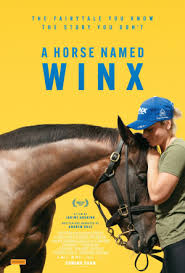
A HORSE NAMED WINX
Australia, 2024, 117 minutes, Colour.
Andrew Rule.
Directed by Janine Hosking.
At the end of her racing career, the horse named Winx – actually, THE would be better in the film’s title than A! – she was named the greatest racehorse in the world, 2018-2019.
Which means that audiences around the world, but especially audiences in Australia, know something of the career of Winx and her achievements, and the achievement of her trainer, New Zealander Chris Weller and her longtime jockey, Hugh Bowman, would be eager to see this highly interesting and entertaining look back into her racing past.
Actually, for audiences who have little or no idea who Winx was, they will be quickly drawn into this story, following step-by-step, listening to the range of interviews, getting to know the trainer well choose one, listening to the opinions of the owners, discussions with the jockeys. And, probably quite emotional, along with the racing fans, by the end of the film – and with the touch of tears as Winx loses her first foal.
We get to know Chris Weller very well also, his methods, his attitudes, and aspects of his biography. And, it is the same with jockey, Hugh Bowman. The audience is invited to identify very strongly with both of them.
Director, Janine Hosking, has been making effective documentaries for over 20 years, more recently into the world of Australian music, The Eulogy on pianist Geoffrey Tozer, Knowing the Score on Australia’s orchestra conductor, Simone Young. She knows how to tell a story well being her audience in.
The film is the biography of Winx, the stud background, birth, initial indications of success, taken on by her trainer, the markets and auctions, early promise, initial races, daring entries in prestige racing carnivals, their increasing wins… For the enthusiasts, plenty of racing sequences.
And, then, the recognition of Winx ‘s abilities, the beginning of the record-breaking long run of 33 consecutive wins, of the prestige races, breaking records, especially for winnings of the Cox Plate. (Any readers nunfamiliar with these races and the reputation of the Cox Plate will be on the edge of their seats not knowing whether Winx was going to break the winning record or not!). So, a very interesting documentary of Australian racing. And, so, a very entertaining portrait and drama of this champion racehorse.
Edward Scissorhands, Matthew Bourne
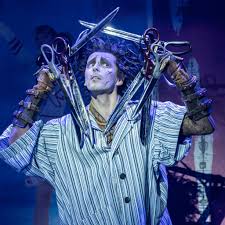
EDWARD SCISSORHANDS
UK, 2024, 90 minutes, Colour.
Liam Mower, Ashley Shaw.
Directed by Matthew Bourne; screen version, Ross MacGibbon.
Edward Scissorhands, 1990, was one of Tim Burton’s most popular films, starring Johnny Depp and Winona Ryder. It was a fantasy, an inventor and his creature who had no hands but scissors. He goes down from his inventor’s Castle into the contemporary world, kindly people, exploitative people, made a fuss of with his ability to shape edges and hair. But, the people turn against him, persecute him, hound him out of the town.
Ballet choreographer, Matthew Bourne, has created many significant ballets, The Nutcracker, the Car Man and an all-male Swan Lake. He choreographed his version of Edward Scissorhands in 2005. Now his 2022 version has been filmed for theatrical release.
This is contemporary dance theatre rather than ballet. Matthew Bourne has choreographed quite a range of individual dances, ensemble dancing as in music theatre, a range of musical styles, especially from the 1950s and 1960s, and a range of dancing styles participated in by Edward himself, quite a moving performance from Liam Mower.
This production keeps the basic outline of Tim Burton’s film and Caroline Thompson’s screenplay with some variations.
The impact of this kind of production for the theatre audience is its view of the whole stage, the effect of distance from the stage, the audience choosing characters to focus on, individuals, but an ensemble experience.
This screen theatrical experience is quite different. There are many ensemble sequences, the audience viewing the whole stage. However, it is also very cinematic because of the camera work, the editing, the decisions for particular focus on characters, close-ups, some extreme close-ups, especially of Edward, choices made by the director but very effective for communicating the drama, the emotions, the development of the characters. Quite a different experience from that in the theatre.
For many, Tim Burton’s film has been a continuing favourite. So has the musical score by Danny Elfman, the main themes are incorporated into this score. For those not familiar with Edward Scissorhands, a surprising experience. For those familiar, and different reliving of the film.
Kid Snow
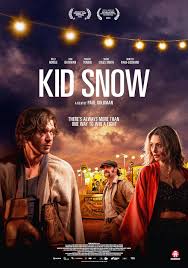
KID SNOW
Australia, 2024, 127 minutes, Colour.
Billy Howle, Tom Bateman, Phoebe Tonkin, Mark Coles Smith, Hunter Page-Lochard, Nathan Philips, Jake La Torre, Robert Taylor, Tristan Gorey, Vito de Francesco, Tasma Walton.
Directed by Paul Goldman.
Once upon a time in Australia, there were travelling fairs, including a boxing troupe, with a boxing tent, featuring boxing stars ready to take on the locals as part of the show. They were popular during World War I and continued. In fact, the story opens in 1961, the main action taking place in 1971. The fairs were very popular, beginning at the time of the introduction of radio, before television, certainly long before social media. In fact, in one sequence here, a boxing bout is watched on television, black-and-white, even in 1971 before the coming of colour TV.
A reviewers noted that this is the kind of film we used to make in Australia. It is a story of ordinary people, very ordinary people, often referred to in the past as “battlers”, and not just because of the boxing, but of the struggles in making a living. The characters here all have these stories, Irish migration, fixed fights and betting, returning from Vietnam, single parents, dancing in Kings Cross nightclubs, aboriginals involved in the boxing troupes, sometimes hand-to-mouth subsistence…
In 1961, we are introduced to two boxing brothers, Rory and Kid. Their father manages them, bets, tough fights, setups, knockouts, Kid knocked down, giving way to his brother – drinking, driving, a disastrous car crash.
1971, Rory, with a limp from his leg injured in the crash, runs the touring fair, Kid being the featured boxer, the backup from some of the aborigines travelling with them. British actor, Billy Howle, plays Kid, looking unkempt, often bewildered, his brother dominating him. British actor Tom Bateman plays Rory. Mark Coles Smith and Hunter Page-Lochard feature in the entourage. Haunting them is the memory of the defeat by the national champion, Hammer (Tristan Gorey) who runs a boxing training centre.
An American journalist, played by Robert Taylor, from Life Magazine is following Hammer, interviewing Rory and Kid, trying to get a story about the boxing world in Australia, such travelling troupes not part of the American boxing scene.
A further complication is Sunny (Phoebe Tonkin), battling with her young son, Darcy, her husband has been wounded in Vietnam, time in jail, slyly picking pockets of the boxing audience, confronted by Rory, becoming a dancer with her own tent, able to survive with her son, a strange relationship with Kid who become something of a babysitter for the boy, creating a bond.
In the background the entrepreneurs are trying to organise a bout between Kid and Hammer (who hates Kid), a set up, betting and profit, Rory indebted to these entrepreneurs, forcing Kid to train.
Which means there are a number of boxing sequences, especially that final fight. However, a lot of the film focuses on personal struggles, the two brothers, resentments, yet brotherly feelings, Sunny and her situation and background, concern for Darcy, the interventions of the American journalist, a truth confrontation between the two brothers.
We know where the story is going but, satisfyingly, it is not exactly what we might have expected and the final, perhaps inevitable, visualising of the meeting leaves the audience satisfied.
- The title and the focus on Kid? In the context of his family? In the context of boxing and the troupe?
- An Australian story, the travelling boxing troupes, the fairs and the fairgrounds, the small country towns, the tents, the shows, boxing, the dancing? The audiences? The tradition from the First World War years to the 1970s?
- The West Australian settings, the small towns, the range of the countryside, deserts, farmland, the coastal sequences? Atmosphere? Musical score?
- The opening fight, the introduction to Kid, Rory, to their father? To Hammer and his trainer, Frank? The situation of the fight, the competition, the bets, the arrangements for knockouts? Kid, his fight, falling? Rory and the arrangement to win? Hammer and his dominance?
- The aftermath, the drive, Kid and his drinking, the arguments, the oncoming truck, the accident? The father’s death? Rory and his leg injury?
- 1971, Rory and the setting up of the travelling fair, the visuals of the tents, exteriors and interiors? The dance tent, the eyes, the lascivious sketches of the women?
- The entourage, Rory as the boss, unable to fight? Kid, the fighter, the locals and taking them on, the bets? The other members of the group, the aboriginal men and their presence, Bill and his being a follower? His later taking Kid’s place in being brutalised by Kid’s antagonists? The atmosphere, their characters, performances, the crowds?
- Sunny, coming into the tent, Rory watching her, picking the pockets, his confronting her, her concern about Darcy in the car? The interactions, the job, her dancing, the money, costumes, the tent and its style, the increasing audiences, their responses to her? Her suspicions of Kid, mellowing, letting him be babysitting for Darcy? The growing attraction? Darcy and his wariness, memories of father, the father and his Vietnam experience? Sunny, her explanations of herself, growing up, jail, dancing at Kings Cross, Betty teaching her? With the bigger audiences, better dresses, more elaborate performances, popularity? Rory and his approach, her resisting, Darcy attacking, her being sent away? Going to the coast, meeting Betty again, the ice cream parlour for the tourists?
- The journalist from Life Magazine, visiting Australia, comparisons with the US, his interviewing Hammer, Hammer at his gym? Interviewing Rory? Interviewing Kid? Rory’s attack on him, typing the story, present at the finale?
- Darcy taking the money, kid in pursuit, Darcy not knowing the money was Kid’s? Returning it?
- Rory, the entrepreneurs, the setting up of the fight against Hammer, Rory and his memories, Kid and his abilities, fixing the match but not telling Kid? Kid the training, the aboriginal trainers and his running, exercise? And continuing with the bouts with the locals?
- The buildup to the confrontation between Kid and Rory, the accident, Rory and his limp, the fixing of matches, treatment of Sunny? Kid leaving, driving, finding Sunny and Darcy, reuniting? The prospect of the fight?
- The decision to fight, going into training, the return, his visit to the entrepreneurs, the bet to win that he could last three rounds? The visuals of the fight, hard, collapsing, lasting the three rounds? Going to the fourth, throwing in the towel, the fans, Rory’s reaction? And the entrepreneur making money, money for Kid?
- The reconciliation with Rory, his going to find Sunny and Darcy, the ice cream parlour, and the way that the final sequence was handled, expected but controlled?
Harold and the Purple Crayon
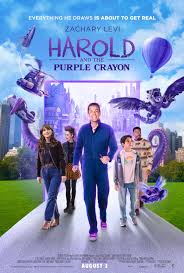
HAROLD AND THE PURPLE CRAYON
US, 2024, 90 minutes, Colour.
Zachary Levi, Lil Rel Howery, Zooey Deschanel, Benjamin Bottani, Tanya Reynolds, Jemaine Clement, Alfred Molina.
Directed by Carlos Saldanha.
Eagerness to see Harold and the Purple Crayon will depend on whether audiences grew up with Crockett Johnson’s classic story and illustrations (and his nine other books in the series as well as the television episodes). Those who do not know Johnson’s books, Harold began life in 1955 as a four-year-old, inhabiting a fantasy world where, if he needed or wanted something, he simply drew it, and there it was. However, in later books, he was an adult.
In this version, Harold is living a happy life, and drawing with his crayon, solving every need with a drawing = and there it is.. He is accompanied by his close friends, Moose and Porcupine. So, a pleasant opening, an introduction into Harold’s world, his conversations, his listening to the voice of his creator, whom he calls Old Man (voiced by Alfred Molina), but with a desire to go out into what he calls “The Real World”.
And, out he goes, in the form of Zachary Levi. Soon after Moose emerges but in human form, played by comedian Lil Rel Howery. But it takes rather a longer time for Porcupine (Tanya Reynolds) who discovers her friends missing, but does not emerge in the real world anywhere close to them, spending a long time in the search, looking for clues – and they are always purple.
And the purple crayon! Whenever Harold draws, it is with his beloved purple crayon. And, when he emerges into the real world, he simply puts his old talent into practice, drawing a purple bike, replacing a flat tire was a purple one, painting of a house, purple no limits – even later, a plane which flies through the city.
Harassed mother Teri (Zoe Deschanel) driving with her son, Mel (a likeable Benjamin Bottani), an intelligent boy who has a secret invisible mini-dragon friend, crashes into Harold and Moose on their bike. Which leads to a whole lot of adventures, searching for The Old Man, all kinds of funny and dangerous escapades and situations, and some villainy in the form of Jemaine Clement, librarian who they think will be able to find The Old Man but, frustrated with his Game of Thrones -like novel not being accepted, steals the purple crayon for dastardly purposes.
The film will appeal to boys of Mel’s age, 13 and down. As regards adult audiences, parents, the difficulty is the character of Harold, a child in an adult’s body, uttering childlike (and childish) comments (and, for this reviewer, difficult because actor Zachary Levi has played the central role in the least liked superhero films, the two Shazams).
But, within the limits it sets itself and the limits for the age audience and identifying with Harold, it can be quite a nice pastime.
- The original books, the story, the sketches? Television episodes?
- The intended audience, children, boys identifying with Harold, the age group, 13 down, identifying with Harold but also with Metal?
- The animation style, bringing Crockett Johnson’s style to life, simple, creative? And the decision to have a purple crayon? And breaking it, Mel having half and being creative, Gary stealing the half, swallowing it, having the power, bringing it up again? The adventures of the crayon?
- Harold, visually, Moose and Porcupine, visuals? Their adventures, Harold drawing, solving every problem? The voice of The Old Man, the creator? Narrative? Harold wanting to find The Old Man, to go into the Real World?
- Drawing the door, going into the real world, in the person of Zachary Levi? His voice and tone? Moose following, transformed into human, Lil Rel Lowrey, African-American? Porcupine later discovering they had gone, transformed, into the girl, but not near Harold and Moose, tracking them down? The detectives and their suspicions?
- Exhilaration in the Real World, looking for the Old Man, the man in the park, his reaction, talking to the detectives? Drawing the bicycle, enjoying the ride, the city, the transition to Teri and Mel, the absent father, the argument, Mel and his invisible dragon friend? The crash? The reaction, the flat tire – and Harold drawing the purple tire?
- Teri, exasperated, mil wanting them to come home, in the house, the room, painting the house purple, the meals and the pies? Teri and her work, not liking it, at the supermarket, her boss and his comments, getting the two to take her place, Mel and the trouble at school? The chaos in the store, pratfalls and mayhem? Teri sacked?
- Mel, the friendship, the visualising of the Dragon?
- The episode of drawing the plane, flying, the exhilaration, the dangers, and the sky writing of Teri’s phone number in the sky, asking for the old man, the incessant number of phone calls?
- The library, Gary, smug, his novel, the fewer the reading, their walking out? His infatuation with Teri? Mel and his dislike? The issue of the old man? Gary offering to help? The drama, getting them into trouble, Gary doing the drawing, the forcing the crayon out of him?
- Happy ending, Porcupine finding them, their being together, Mel happy, his mother? And the glimpse of Gary and his imagination and Teri in his fantasy, turning him down?
- Younger audiences identifying with Mel, with Harold, the impact for parent audiences?
Man from Cairo, The
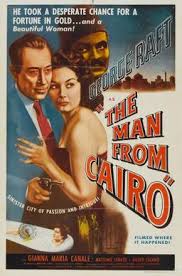
THE MAN FROM CAIRO
US, 1953, 82 minutes, Black-and-white.
George Raft, Gianna Maria Canale, Massimo Serato, Guido Celano, Irene Papas.
Directed by Ray H. Enright.
An example of the small-budget studio producing action films, often as supporting features. This film was made in Italy, using many Italian actors, including Ginna Maria Canale, very popular at this time. There is a surprise brief experience by Greek actress, Irene Papas, in one of her earliest roles, surprising as a young dancer in the club considering the very serious roles in her later career.
But, this is George Raft film. Initially a dancer, he had emerged during the 1930s in serious roles and continued through the 40s and into the 1950s, archetypal a as the gangster in Some Like it Hot. He had a fan base but many considered him very wooden in his performances. And, for those who think that this is the case, this film offers probably the best evidence.
There is quite a complex set up in the plot, gold bullion stolen during World War II, hidden in Algiers, the French government wanting it back, gangster connections stealing it. There is a survivor of the initial attack who is wanting to communicate the truth and benefit by it, a French general who has been blamed and wants exonerate himself, but from the audience point of view he acts very suspiciously. Then there is the local police, especially when the singer in the night club is murdered.
The French government have organised an American businessman to do the investigation in Algiers but first sent him to Saudi Arabia to produce a cover of his work in the oil industry. At Cairo airport, he meets an old friend, George Raft, who had served in Algiers during the war, indicating that he will be coming back to Algiers searching for a man with four fingers.
Raft is mistaken for the American undercover agent, taken by the police and interrogated, the subject of pursuit by the local thugs, his room searched, waking up to find the dead woman, and her friend appearing as he came to and his fleeing. She describes him to the police but then denies that he is the man, most improbably attracted to him but according to the screenplay almost immediately falling in love with him, introducing him to the local casino owner – all after the gold.
There is a twist, an entrepreneur illegally transporting the gold out of Algeria, disguised now as coins and hidden in the trains. Raft has been in contact with an authority with a rendezvous at the back of a fortune teller’s tent. But, he is the entrepreneur – leading to quite a confrontation, police, fights and shootouts, and an improbable romantic happy ending.
And, the strange thing, all throughout the film George Raft walks through Algiers and into the action sequences wearing coat and tie, often with a hat, standing out so obviously with all locals in the way they are dressed.
This was the last film by Ray H. Enright who had worked with Mack Sennett, editing, scripts, and had directed quite a number of fine westerns over the decades.
God + Country
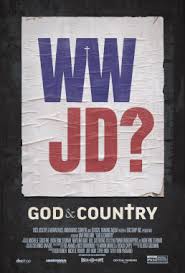
GOD + COUNTRY
US, 2023, 90 minutes, Colour.
Directed by Don Partland.
Award-winning director, Don Partland, begin a trilogy of films in 2020 focusing on the personality of Donald Trump, his years as president, his psychology, especially an analysis of narcissism. The film was released during the election year of 2020, an expose of the president as unfit for office.
God + Country was released in 2023. While there are excerpts from the public life of Donald Trump, the focus this time is on evangelical Christians. The thesis is that from the 1970s and 1980s, evangelical Christians became more and more politicised, thinking and feeling that they were under threat, relying on literal interpretation of biblical texts for their self-righteousness, identifying more and more with American right political stances.
The film offers a look at many of the evangelical Christian leaders, in their local churches, in the media, radio, and especially tele-evangelists. With their leadership and the atmosphere of feeling under threat, the vast amounts of financial contributions collected, the filmmakers suggest that there was a transition from this evangelical Christianity to more political perspectives, Christian Nationalism. And, this was very much supported by Donald Trump, irrespective of whether he was a believer or not, irrespective of his personal life and values.
The film also shows the transition to extreme right-wing groups, their invocation of Jesus Christ, Christian beliefs, specific references to biblical apocalyptic statements. It highlights that with the threat of dire end in times, the promoters of Christian Nationalism fostered an atmosphere of fear, salvation coming from the defenders on the right.
With the visuals of the storming of the Capital in January 2021, there is a climax of this kind of Christian Nationalism, the documentary highlighting images of Jesus on banners, biblical quotations, the Christian motivation of so many demonstrating, taking anti-government stands with violence, believing the lies of Donald Trump about the election being rigged.
With the release of the film in 2023, it has a significant role during 2024 and Donald Trump’s campaign for a second term as President.
Donald Partland’s third part of his trilogy is #UNTRUTH The Psychology of Trumpism, exploring further the psychology of Donald Trump himself and his followers, rabid, the right wing, the Christian Nationalists.
August Virgin, The
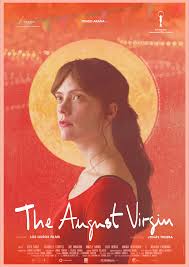
THE AUGUST VIRGIN
Spain, 2019, 125 minutes, Colour.
Itsasa Arana, Vito Sanz.
Directed by Jonas Trueba.
The Truebas have been significant filmmakers in Spain, especially Fernando, with his brother, David. The August Virgin has been corrected by Fernando’s son, Jonas.
This is very much a film for 30 somethings. 20 somethings are probably too busy with their lives to be so empathetic with Eva, the central character here, age 33, taking time off to reflect on her life and its directions. 40 somethings plus may well be impatient with Eva as they watch the film.
The introduction tells us that citizens of Madrid leave for the summer, leaving the city to tourists and to a range of entertainers as well as for celebrations of religious festivals, glimpsed during the film.
The structure of the film is a literal calendar, indicating the beginning of each day for the first 15 days of August. Eva writes a diary but the film is something of a visual diary for the audience. Some of the days are filled with action, some have only brief glimpses.
She takes up an apartment, described in great detail on the first day, base for her when she decides to go out, and as a tourist, other times just wandering, encountering an old friend at the Museum and discussing old times with him, and a drink; another time going to the cinema and meeting two old friends, further discussions; at the cinema she listens to 2 women talking and asks one of them to accompany her home for a special female massage; another time she is concerned with the man she fears is standing in a dangerous place, talks with him, befriends him, fascinated, the next night following him, talking, a sexual encounter, highlighting her preoccupation with being pregnant.
There is indication that after the first 15 days of August, she has come to some terms with herself, very much preoccupied with pregnancy – and some enigmatic references to being pregnant, no father, memories of the Virgin Mary.
Varied reactions – sympathetic audiences very involved, others irritated and bored.
- The director, his family, films and reputation?
- Madrid, the first half of August, the summer, the heat, the streets and crowds, the festivities, the concerts, the music? Apartments, bars, city locations? The musical score, the range of songs?
- The introduction, the explanations, citizens of Madrid leaving, the heat, but the celebrations in the city, the tourists? The glimpse of tourist buses and their destinations, the tourist crowds in the streets, the concerts and performances?
- The use of the calendar for the first half of August, indicating days?
- The introduction to Eva, at the apartment, the long speech from the apartment owner, his writing, interested in 1930s movie comedy and its stars, his going on vacation, showing her every detail of the apartment? Her accepting it? Relaxing in it?
- Eva, the audience not knowing much about her, in her 30s, revelation that she was an actress, gradual revelation of friends, relationships? Her reason for staying in Madrid, wanting to understand herself, being alone, her identity, the issue of pregnancy?
- The succeeding days, the keeping a diary, the film is a visual diary?
- The scenes of her wandering around, observing, in the tourist bus, following the Asian tourist, going to the museum, the encounter with her friend, his continued talking, writing articles, breakup with his girlfriend, the aftermath, her having a drink with him, his getting drunk?
- Going to the cinema, meeting the two friends, the conversations, relationships, the past, her self-consciousness, their going into the film, Eva not going, going home, writing in the diary?
- The next day going to the cinema, listening to the two women and their talk, meeting them afterwards, going home with Maria, the rituals and massage, women’s massage, periods, pregnancy?
- Seeing Agos behind the glass, her concern, crawling under the glass, the long conversation with him, actor, working at the bar, his girlfriend, the daughter with her and her boyfriend? The long talk, attraction? Her going home?
- Going to the concert in the city, the performance, dramatics, music, her enjoying it, rapt with the music? Meeting the two women again, the conversations?
- The bar, seeing Agos, later following him, their talking, the walk home, the possibility of an apartment, the room, the sexual encounter, his sleeping, her consciousness of pregnancy?
- The next day, with Agos and his daughter, the family group, the daughter and her very direct questions about pregnancy, the father, the comparisons with the Virgin Mary?
- At the end of the period, Eva and her self-understanding, looking in the mirror, her naked self, the pregnancy, her wishes, joining with a gloss and his daughter, happy times together, her future?